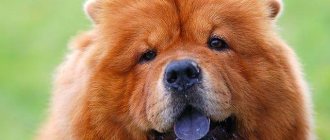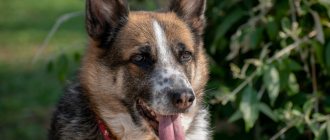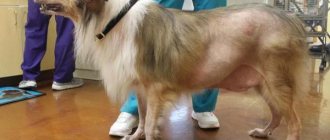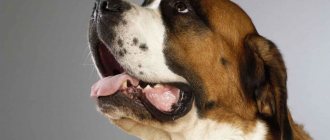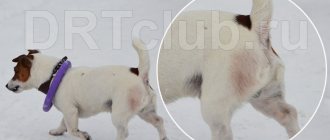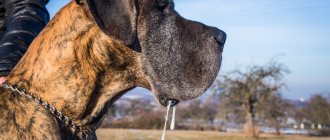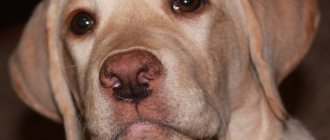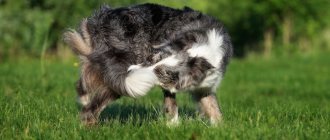Means of communication
Their olfactory receptor membrane is so convincing that they can recognize many things by smell. Our nose has an olfactory layer that has 5,000,000 receptors compared to dogs. They have 225 million receptors.
When they sniff the butt, they can find out whether their companion is male or female, whether they are in a heat cycle, the exact age of the dog, and whether the other dog is healthy or not.
Dogs have a unique Jacobson's organ in their snout that detects glands that secrete chemicals. This particular chemical helps them learn a lot about the dog. This also helps them ignore the foul odor of another dog's feces.
© shutterstock
Sexual desire
The introduction of any dog follows the same scenario. The first is the meeting of noses, the second is a shoulder bump or contact with the sides, and then sniffing under the tail. You may not have noticed the first two stages, but if you watch, you will be convinced of the truth of this theory. This is an iron rule; all four-legged animals follow it, regardless of age and gender. There is only one exception - sexual desire and aggression for the same reason.
If the situation does not seem tense to the male dog, when he meets a female dog in heat, he will follow the usual algorithm, but if there are competitors nearby... the stakes are too high. The male will try to quickly dive under the bitch’s tail; the smell will give information about whether the female is ready for mating. In the process of obtaining information, the impudent dog may be attacked by another male, even without an introduction or greeting.
In the world of mature dogs, arrogant sniffing under the tail is fraught with a slap in the face. For example, in a pack of wolves, only the leader and the alpha female have the right to sniff everyone. If a puppy or young wolf dares to poke his nose into, for example, the alpha female without permission... he will be punished by the she-wolf, the leader, and those who were simply nearby.
Greetings to comrades
This is a common dog way of greeting someone. In addition, dogs tend to sniff everything, because this is how they understand and feel many things. This is one of the ways to communicate and get to know each other better. Their faces capture and convey a lot about their friends.
There is an anal gland in the back that helps dogs recognize the scent of their mates. Every man, cat and dog has a unique scent. But dogs have powerful olfactory organs that distinguish the smell of one dog from the smell of another.
"Natural" reasons
Probably every dog owner has wondered at least once whether the pet is not guided by some perverted motives, sniffing under the tail of a relative? Having found no logical explanations, most dog breeders decide that this is a “tribute to nature” and the issue becomes irrelevant. If you are overcome by curiosity and want to know the true reasons for the behavior of your ward, you are at the right place.
On one of the dog breeders' forums, an outrageous situation is described, which the owner made public in good health and mind. The man did not understand the pet so much that he decided to try to behave similarly towards his dog. Simply put, the owner was so interested that he decided to get on all fours and sniff his ward’s tail. It is not known what exactly the curious owner expected, but the results disappointed him. The man did not smell anything specific and decided to pour out his soul to those who would understand him - fellow dog breeders.
The man did not find anything specific for a simple reason: the human sense of smell is not able to detect the smell that interests dogs. Regardless of gender, along the rim of the dog’s anus there are glands that secrete a special secretion. When the dog is healthy, the smell of these secretions is barely perceptible or not felt at all by humans. The man simply could not discover the actual answer to his question due to his own physiology.
For dogs, the smell released with secretion is very distinct and informative. Regardless of the gender and intentions of both dogs, tail sniffing provides the following information:
- Age – puppies and mature dogs do not have an individual smell; this is a matter of safety and survival.
- Physical strength and strength - the composition of the secretion of small dogs and large four-legged animals is very different, that is, it has a different smell.
- State of health - an abnormal odor indicates illness, and if our dogs were wild, the weak and sick would be attacked by stronger and healthier individuals (even of the same species).
Develop good behavior
Allowing your dog to sniff the butts of his fellow dogs will create a healthy relationship between them. This will prevent them from exhibiting aggressive behavior. Every dog loves to be sniffed and loves to sniff someone else's butt. Some can smell for long hours and some can inhale for a shorter time.
If another dog is comfortable with another dog sniffing its butt, don't worry.
Otherwise, keep your dog away from others. Never allow your dog to spend too much time in the company of another dog. When they manage to understand each other better, they will start fighting each other. Let them be in each other's company for a while. After this, separate them to avoid sparring between them.
Should I let my dog sniff other dogs?
If both dogs are healthy, well socialized and supervised, it's actually a good idea to let them "sniff" as much as they want (provided each dog tolerates it well).
Dogs may be less likely to fight if they spend enough time with each other to learn how to sniff you.
However, some dogs may sniff intensely, while other dogs need their own space.
Monitor the behavior and body language of all dogs. If one dog is overdoing it and another seems irritated or nervous, owners should recall their dogs.
Additionally, it is ideal for dogs to meet and play in pairs. Dogs are more likely to become overexcited in groups, which can lead to fights.
Many glands
The anus is a part of the body that contains many glands. When a dog sniffs a butt, it tells them many stories about its friend. They recognize each other the same way we recognize each other's faces.
This is how they recognize their close friends by smell. This is their daily routine, and you don't need to feel awkward if he does this when you go out with him or take a stroll to a nearby park. Let him hang out with his friends.
These dogs smell not only a dog's back, but also a cat's and human crotch. But why do they sniff people?
© shutterstock
Legend
Finally, a folk legend explaining the strange manner of our pets. A short cartoon was drawn based on this version, which I must say is very funny.
So, a long time ago, when people still ran around in skins and fire was “magic,” dogs decided to live on the moon. The motivation of the four-legged animals was very clear; they did not want to be just animals and live a “dog’s” life. Since in those days there was no transport, much less space engineering, the dogs decided to build a living pyramid to the Moon.
On the appointed day, the four-legged creatures began to gather. Everyone was impatient and the pyramid began to rise. The mountain of dogs kept growing and now, the four-legged one standing at the top was already ready to bite her on the “cheese” side... when the pyramid began to fall apart. The culprit was quickly found; the dog standing in the front row felt indigestion and ran into the bushes. Since then, all dogs, when they meet, sniff each other's tails to determine whether the new friend will survive in the pyramid until the moon.
Why do dogs smell people or their owners?
By now we have realized that these canine creatures are scent-oriented. Their snout sniffs the area between the thighs and knees of the human body in search of information about the person. We humans feel bad when he does this.
It tries to find out information the same way we read the status messages that our friends update on Whatsapp or Facebook. Our human body produces pheromones that convey all the information about us. These glands that produce this chemical are more concentrated in our genitals and armpits.
The dog sniffs the butt to find out the exact character of people. For women, he can see if she is on her menstrual cycle and if a particular girl is pregnant. Moreover, in dogs, the glands that secrete the hormone that helps it detect information are distributed throughout the body, while in humans they are divided into the groin and buttock areas.
Your dog's sense of smell
The dog's olfactory system is complex and developed, so its sense of smell is far superior to that of humans. To give you an idea of the difference, consider the fact that humans have about 5 million olfactory receptors in their noses, while dogs have about 220 million.
Dogs can smell layers upon layers of scents even when we can't smell anything. Impressive nose.
If you had a nose like that, you'd probably smell everything too! Dogs sniff everything in their path for two main reasons:
- Pleasure: Things smell good! Sniffing things is fun. The sense of smell is pleasant and stimulating.
- Information: Dogs want to find out or learn more about something or someone.
Myths associated with snorting
Sarcastically, there have been cases where people mistook the dog's behavior for sexual harassment. Some even went so far as to file a case against the dog. We should never humanize the behavior of dogs because they are trying to understand us, not rape us.
Owners should be careful when training their dog to prevent it from sniffing the private parts of neighbors or guests. This behavior, although normal for dogs, is very annoying for people.
This behavior has become especially popular among people who have recently entered into sexual relations. New mother girls who are on their menstrual cycle also feel very uncomfortable as they sniff their genitals in an impolite manner and uncontrollably.
Nature gave abilities, and man found application
There is a theory that a dog's memory stores all the "individual dog scents" its nose has ever smelled. It is impossible to find an exact confirmation or refutation of this hypothesis, however, situations are not uncommon when a pet, meeting a “childhood friend,” begins to communicate with him as with an old friend.
The habit of animals, when they meet, to bury themselves under the tail of their fellow animals prompted people to use it for diagnostic purposes. Dogs quite often make it clear to the owners of their companion that their pet is unwell. Laboratory studies were carried out that confirmed the effectiveness of this innovative diagnostic method.
In 2004, the results of a study appeared in the pages of the British Medical Journal proving that in cancer, the human body produces odorous substances, and the sensitive sense of smell of dogs allows them to sense it. These data created a sensation in medical circles and immediately gained recognition at the global level.
Ways dogs communicate with each other and with people
When answering one question, another immediately arises. Do dogs understand each other? If so, how?
One of the ways of friendly communication between animals is licking. Why do dogs or other animals lick each other? Licking among our four-legged friends is a manifestation of tender, friendly feelings and affection. It is natural for dogs to lick each other. From the very first day the puppy is born. In this way she takes care of her child and calms him down. As the dog grows up, he may show similar actions to his close friends whom he trusts. Also, touching with the muzzle: tongue, nose can be signs of attention and friendliness. When licking the muzzle of another individual, the dog not only says hello, but also determines by smell where it has been. While walking, your pet may exchange several of these “kisses” with another dog to make sure that it is his friend. A small young dog may lick a more experienced male to appease him. The dog shows the same signs and habits towards its owner.
Often, dogs want to lick a person's face or “kiss” their nose. This action signifies an expression of great affection and love. You can't react to this aggressively. The dog will not understand why you have such a reaction and will perceive its owner as a person with whom it is difficult to contact. The desire to touch the owner’s lips is also associated with the behavior of wolves in their natural environment. When the puppies are small, the mother dog regurgitates food for her young. In order to get food, puppies reach for their mother's mouth. This instinct has been preserved in dogs. That is why you should not scold your pet if he is constantly trying to reach your mouth. Sometimes, after you scold your pet, the dog reaches for your mouth. With this gesture, she invites you to be friends again. The same action on the part of the dog occurs when its owner comes home from work or school. Welcome jumps, tail wagging, joyful whining and mouth open with joy are an expression of pleasure. It is important to always respond to your dog with kindness. Even if you are very busy, spend a few seconds with your pet, so he will not feel unwanted.
Dogs use licking to communicate with their friends. Do unfamiliar dogs understand each other? Certainly! They know how to “talk.” This communication system consists of signs and smells. For example, a raised, wagging tail on a dog means happiness and trust, a “pipe” tail means anxiety, a tucked tail means fear, and many others.
Thus, if someone asks you why unfamiliar dogs sniff each other’s tails in the first place, you can safely answer that this is their usual way of greeting. After all, dogs are very intelligent creatures with many habits and instincts.
What does the smell from under the tail mean?
In healthy dogs, the smell of secretion is elusive to the human nose or is felt very, very weakly. But for his fellow humans he has a lot of useful information. What can this “personal” scent “tell” about?
- Age . The secretory fluid of puppies and dogs that have reached puberty does not have an individual odor. In this way, nature made sure that the animals remained invisible and their survival rate was higher.
- Physical ability and power . The composition of the secretion of small animals and large animals is different and, accordingly, has a different aroma.
- Health status . The smell from under the tail of a sick dog becomes abnormal and signals that this individual is weak. In the wild, she would have faced inevitable death from the claws and paws of stronger and healthier individuals. What can you do, natural selection.
This is interesting: When to castrate a cat - the optimal age for surgery
Conductor for smell
Given that all these scent signals come from the nose, it's no surprise that a dog's brain has a larger olfactory cortex than a human's. Just like humans, different parts of a dog's brain specialize in different things.
Indeed, the scent region of a dog’s brain is 40 times larger than ours. In fact, one-eighth of a dog's brain is dedicated to smell interpretation.
It's even bigger than the part of our brain dedicated to interpreting vision. So it's not hyperbole to suggest that a dog's sense of smell may be even more powerful than human vision.
Features of “dog” relationships
If you observe dog meetings, you will notice that they act according to a certain algorithm:
- first - nose to nose;
- then – they touch sides;
- and finally, interest in the anal area.
This rule is ironclad, and animals of all ages and genders adhere to it. Only one thing can unsettle a dog - sexual desire and the aggression caused by it. If, having met a female in heat, the male does not feel competition, the traditional meeting ritual does not change.
But if other males interfere in the situation, then the dog will not “shuffle around” and will immediately proceed to the third point, omitting the first two, in order to be the first to fish out the necessary information “from under the tail” - whether the bitch is ready for mating.
But at this time he finds himself in a dangerous situation - competitors are not asleep and can attack, also without a greeting. And the “bride” herself can be very categorical. In the world of adult animals, impudent sniffing under the tail can end in a slap in the face. For example, among wolves, only leaders and alpha females have the privilege of sniffing anyone. Similar behavior of puppies and young animals is strictly punished, and punishment awaits them both from the she-wolf, the leader, and from others.
When smell signals problems in the body
Since the secretion is an indicator of health, it can provide signals about ongoing pathological changes. If an unpleasant odor begins to emanate from the dog, and she sniffs and licks under her tail more often than usual, then there is reason for concern.
Such phenomena may indicate one of two problems:
- the dog has become infected with worms - the pet should be given an anthelmintic;
- metabolic disorder - in this case, the smell may be completely absent, but the consistency of the liquid changes - it thins out or, conversely, thickens.
Another nuance is that dogs often experience blockage of the paraanal glands, in which case professional help is required. If you do nothing, the gland becomes inflamed, causing itching and pain. Due to uncomfortable sensations, the animal begins to itch the “causal” area on the floor and ground, the delicate skin of the anus is injured, and infection penetrates into the wounds.
To avoid complications, you should consult a veterinarian who cleans the anal glands. If this is not done, an advanced form of the disease may require surgical intervention to remove them.
Physiology of smell and the influence of glands on health
From a physiological point of view, everything is quite simple. Dogs are designed in such a way that their dominant sense over all others is smell. And the physiology is such that the brain sends a signal, giving the command to collect as much information as possible in a short time.
Having seen another dog, the first place our “little brother” goes to collect information is down the drain. This is where the whole secret is revealed. The dog has paraanal glands . They accumulate a secret with a whole range of odors. This “aroma” will most quickly provide the dog with all the information that can be used to understand the age, gender, hormonal state and even the health status of the “tailed acquaintance”.
The dog's brain is designed in such a way that all the smells that it smells every day are stored for life and emerge in memory as soon as they are repeated. Therefore, the dog may not visually recognize the other one, but when sniffing, it will definitely remember it.
The condition of the glands is of no small importance for health and behavior . In a normal state, they should be cleared of secretions on their own during bowel movements. Typically, wild packs and dogs living outside do not have problems.
There are practically no problems in dogs that eat balanced and high-quality food. However, some still have problems. Namely, stagnation of secretion in the paraanal glands. In this case, the dog feels discomfort, itching, and in advanced cases, pain. You can immediately notice that something is wrong with her. She will be restless, will often lick herself, bite the base of her tail, and “ride” on her butt. That’s when you need to take care of cleaning the glands. The procedure is simple, but the first time it is better to consult your veterinarian and carry out cleaning.
As practice shows, a dog that has already had its glands cleaned requires this procedure regularly. Without this, the dog will be restless and irritable. Sniffing such a dog will do nothing, but will only disturb or anger it.
If the dog is healthy, it is satisfied with the whole set of smells and it does not feel threatened, then it begins to joyfully and often wag its tail, while spreading the smell even stronger and over a greater distance. If the dog smells a more dominant smell, it instinctively tucks its tail under itself, preventing the smell from spreading, thereby saying “I don’t want to continue communicating with you.” When two aggressive individuals meet, we can also observe tail wagging, only with a wide amplitude, which also releases a secretion, and by this smell the dogs can decide who is more important without resorting to a fight.
Our pets behave in the same way towards us humans. You may have repeatedly seen a dog happily wagging its tail to its owner, or timidly tucking its tail when meeting a suspicious stranger. Instinctively, they spread their scent when they see other people and animals. If the glands are healthy, a person will not recognize this smell.

